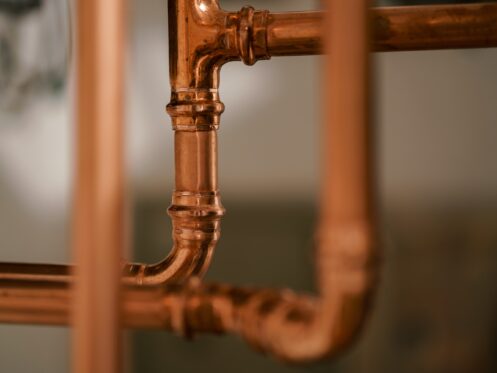As winter approaches, homeowners in Glendale, AZ must prepare their plumbing systems to prevent seasonal issues like frozen pipes. Although the area rarely experiences extremely cold weather, with temperatures averaging 47 in winter, we sometimes get the occasional cold spell. Preparation ensures your pipes will not become damaged. Pipe insulation also protects against heat loss to boost system efficiency. It is important to understand the steps involved in pipe insulation.
1. Identify Your Most Vulnerable Pipes
Before insulating pipes, you must know which are most vulnerable. The most vulnerable pipes are in areas without temperature control, including basements, crawl spaces, garages, and attics. Pipes in exterior walls may also be susceptible to freezing.
You should call a plumber for a home plumbing inspection. We will check the exterior walls, unfinished areas, and outdoor plumbing lines. Once you receive a full report of the vulnerable areas, you can decide on insulation protection.
2. Select the Correct Insulation Materials
Several options exist for pipe insulation, each with unique benefits. Plumbers consider the climate, pipe material, and location to determine which insulation will work most effectively.
Foam Pipe Insulation
Foam pipe insulation is the most common and affordable option. It is lightweight, readily available, and offers applications that involve pre-slit tubes that wrap around the pipes.
However, it does not provide ample protection for areas that regularly experience brutally low temperatures. Foam pipe insulation comes in a few varieties. Polyethylene foam is the most common and can be used for hot or cold pipes. Ethylene vinyl acetate foam is more advanced because it includes a rubber additive. There is also polyurethane foam pipe insulation.
Fiberglass Pipe Insulation
Because of its heat resistance, fiberglass is ideal for pipes carrying higher-temperature water. These options usually include a vapor barrier that helps prevent condensation that can lead to freezing. Fiberglass options also include pre-formed rigid sections available with foil barriers. Fiberglass batts and blanket or roll types are also available for specific pipe applications.
Rubber Pipe Insulation
Rubber is excellent for pipes that expand and contract or have curves. It is more flexible than foam. We use these pipe coverings for water heater lines, but you can apply them to any pipe. Rubber pipe insulation is highly durable and provides excellent protection against condensation.
There are multiple kinds of rubber pipe insulation, including closed-cell rubber, which features a dense structure that can be used for cold or hot water lines. There are also open-cell options that are more porous. Open-cell rubber pipe insulation offers insulation but may not provide the best level of condensation protection.
Heat Tape and Cables
Electric options, such as heat tape, can protect against cold extremes to prevent freezing. Plumbers usually use this product in extremely cold climates. There are automated pipe insulation options that automatically adjust the heat based on the surrounding temperature. Constant-wattage heat cables provide consistent heat along the entire length.
Before deciding on a pipe insulation material, consider a few factors. First, assess the kind of pipes you have. Common materials include PVC, fiberglass, and copper. You should also consider the installation point. Outdoor pipes may require further protection against material breakdowns, such as those offered with UV-resistant insulation.
Moisture-protective pipe insulation can benefit indoor pipes, especially in humid areas like bathrooms. Moisture protection, such as condensation wicking, can help prevent mold and mildew growth that compromises indoor air quality. Since Arizona temperatures stay milder in winter, you will not need to consider the thickest pipe insulation options made for zones with regular frigid temperature drops. We can help you select the proper pipe insulation for effective protection.
3. Measure Your Pipes
To ensure you purchase enough insulation, you need to know the diameter and length of each pipe. Pipe insulation usually comes in standard sizes; some, such as rubber coverings, offer one-size-fits-all fittings.
To measure the diameter, use a flexible fabric measuring tape and wrap it around the broadest pipe point. Then, measure the length from one end of the pipe to the other. A plumber can perform these measurements for you, and we come equipped with various types and sizes of pipe insulation for efficiency.
4. Install the Pipe Insulation
Installing pipe insulation is relatively straightforward for easy-to-reach pipes. However, installing pipe insulation in walls, ceilings, or under flooring can become more complex. The installation steps vary according to the material.
Foam Pipe Insulation
Foam pipe insulation is one of the most manageable installations. It is usually self-sealing and quickly wrapped around the diameter of the pipe. It can be cut to length to fit various pipes.
Fiberglass Pipe Insulation
Plumbers wrap fiberglass insulation around the exposed pipe in overlapping layers that offer extreme protection against the cold. They must use a special plumber’s tape to secure the fiberglass wrap to the pipe section, ensuring the vapor barrier remains intact.
Rubber Pipe Insulation
Rubber pipe insulation has two application options depending on the type and brand. This includes wrapping the material around the pipes or sliding it in place. Most rubber insulation has self-sealing applications for tight seals. Plumbers need exact pipe measurements because the rolls are thick and require precise cuts.
Heat Tape or Cables
Heat tape and cable applications require a professional plumber to ensure proper installation and adherence to the manufacturer’s instructions to protect the warranty coverage. Plumbers wrap the pipes in heat tape or cables and secure them with electrical tape for a strong seal.
6. Check for Gaps or Openings
Once installed, plumbers check the pipe insulation to ensure no gaps or openings could result in frozen lines. Spray foam or caulk effectively seals gaps where lines run into walls or under flooring. The added protection helps stop drafts that can increase the risk of freezing.
7. Maintain Your Insulated Pipes
Regular maintenance will ensure continued protection. It is important to schedule a yearly plumbing inspection, usually in late summer or early fall. Our team will inspect insulated areas for signs of damage or moisture buildup. Depending on the material, pipe insulation can last many years.
Benefits of Pipe Insulation
Pipe insulation offers several benefits, most importantly, frozen pipe protection. Frozen pipes can burst, leading to expensive damage as they melt. Pipe insulation helps to protect against temperature extremes that can cause freezing in the lines.
Insulation benefits hot water pipes, preventing heat loss and improving energy efficiency. It can also help reduce condensation, which leads to mold and mildew growth.
Many Glendale residents are surprised that pipe insulation can reduce noise, especially in older homes where pipes may rattle. By having us install pipe insulation, you can experience a quieter home environment. Christian Brothers Air Conditioning Plumbing Electrical provides a wide range of plumbing, electrical, and HVAC services, including installation, maintenance, and repairs. Our plumbing services include tankless water heaters, water filtration, drains, and sewers. Our electricians offer services for electrical panels, surge protection, and EV charging stations. We provide HVAC services for all makes and system types, including ductless mini-split systems.
If you want to learn more about pipe insulation options in Glendale, contact our expert plumbers at Christian Brothers Air Conditioning Plumbing Electrical.










